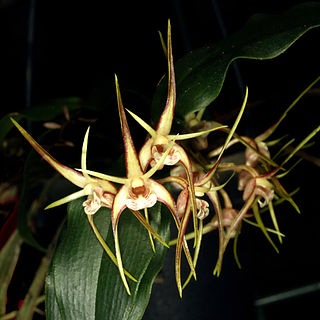
Calamus is a genus of the palm family Arecaceae. These are among several genera known as rattan palms. There are an estimated 400 species in this genus, all native to tropical and subtropical Asia, Africa, and Australia. They are mostly leaf-climbing lianas with slender, reedy stems. To aid scrambling some species have evolved hooks on the underside of the midrib, or more commonly by modified "pinnae" or tendrils in the form of stout, backward-pointing spines. These stems may grow to lengths of 200 metres.
Seidelia is a plant genus of the family Euphorbiaceae first described as a genus in 1858. The genus is endemic to Southern Africa.
- Seidelia firmula(Prain) Pax & K.Hoffm - Namibia, Cape Province
- Seidelia triandra(E.Mey.) Pax - Namibia, Cape Province, Free State

Rondeletia odorata is a species of flowering plant in the coffee family. It is native to Cuba and Panama. It is cultivated elsewhere. Common names include rondeletia, Cleveland Sunrise, and Panama-rose.
Apodiscus is a genus of trees belonging to the family Phyllanthaceae first described as a genus in 1912. It contains only one known species, Apodiscus chevalieri, native to tropical West Africa.

Papuacedrus papuana is a species in the conifer family Cupressaceae, the sole species in the genus Papuacedrus. Some botanists do not consider this species as forming a distinct genus, but include it in the related genus Libocedrus. It is native to New Guinea and to the Indonesian Province of Maluku.

Chambeyronia macrocarpa is a species of palm tree commonly known as the red leaf palm. It is sometimes called the flamethrower palm. The species is endemic to New Caledonia.

Aloidendron ramosissimum, formerly Aloe ramosissima, is a species of flowering plant in the family Asphodelaceae. It is endemic to the Richtersveld at the border between South Africa and Namibia, where it grows on desert slopes and in ravines. Its common name is maiden's quiver tree.
Strumaria is a genus of African plants in Amaryllis family, subfamily Amaryllidoideae. The genus is known in nature only from South Africa, Lesotho and Namibia.

Melaleuca lanceolata commonly known as black paperbark, moonah, Rottnest Island teatree and western black tea tree is a plant in the myrtle family, Myrtaceae and is native to Australia where it occurs in Western Australia, South Australia, Victoria, New South Wales and Queensland. It is a densely foliaged tree with rough bark, which flowers prolifically in summer.

Dendrobium bigibbum, commonly known as the Cooktown orchid or mauve butterfly orchid, is an epiphytic or lithophytic orchid in the family Orchidaceae. It has cylindrical pseudobulbs, each with between three and five green or purplish leaves and arching flowering stems with up to twenty, usually lilac-purple flowers. It occurs in tropical North Queensland, Australia and New Guinea.

Dendrobium tetragonum, commonly known as the tree spider orchid, is a variable species of epiphytic or lithophytic orchid endemic to eastern Australia. Tree spider orchids are unusual in having pendulous pseudobulbs that are thin and wiry near the base then expand into a fleshy, four-sided upper section before tapering at the tip. There are only a few thin but leathery leaves at the end of the pseudobulbs and up to five flowers on relatively short flowering stems. To allow for the variations in the species there are five subspecies and a variety, some with a unique common name.
Oryzidium is a genus of African plants in the grass family.

Acer heldreichii, common names Heldreich's maple, Greek maple, and Balkan maple is a European species of maple. It is native to Greece, Bulgaria, Romania, Albania,Macedonia, Montenegro, Kosovo, Serbia, and Bosnia-Herzegovina.
Bridelia mollis is a tree in the family Phyllanthaceae. It is native to southern Africa.
The World Checklist of Selected Plant Families is an "international collaborative programme that provides the latest peer reviewed and published opinions on the accepted scientific names and synonyms of selected plant families." Maintained by the Royal Botanic Gardens, Kew, it is available online, allowing searches for the names of families, genera and species, as well as the ability to create checklists.

Euclea pseudebenus is a tree native to Angola, Namibia and the Cape Province region of South Africa. It is classified as a protected tree in South Africa.
Craspidospermum is a monotypic genus of plant in the family Apocynaceae endemic to Madagascar. As of August 2013 the World Checklist of Selected Plant Families recognises the single species Craspidospermum verticillatum.
Diplorhynchus is a monotypic genus of plant in the family Apocynaceae found in tropical and southern Africa. As of August 2013 the World Checklist of Selected Plant Families recognises the single species Diplorhynchus condylocarpon.
Schizozygia is a monotypic genus of plant in the family Apocynaceae found in tropical Africa and the Comoros. As of August 2013 the World Checklist of Selected Plant Families recognises the single species Schizozygia coffaeoides.

Tinnea is a genus of plants in the family Lamiaceae first described in 1867. It is native to sub-Saharan Africa.
- Tinnea aethiopicaKotschy ex Hook.f. - widespread from Mali to Somalia south to Mozambique; naturalized in Trinidad & Tobago
- Tinnea antiscorbuticaWelw. - Zaïre, Zambia, Angola
- Tinnea apiculataRobyns & Lebrun - eastern Africa from Rwanda to Mozambique
- Tinnea barbataVollesen - Swaziland, northern South Africa
- Tinnea barteriGürke - western Africa
- Tinnea benguellensisGürke - Angola
- Tinnea coeruleaGürke - Zaïre, Zambia, Angola
- Tinnea eriocalyxWelw. - Zaïre, Angola, Botswana, Namibia
- Tinnea galpiniiBriq. - Mozambique, Swaziland, South Africa
- Tinnea gossweileriRobyns & Lebrun - Angola
- Tinnea gracilisGürke - Tanzania to Zambia
- Tinnea mirabilis(Bullock) Vollesen - Tanzania
- Tinnea physalisE.A.Bruce - Tanzania
- Tinnea platyphyllaBriq. - Zaïre
- Tinnea rhodesianaS.Moore - South Africa, Namibia, Zimbabwe, Zambia, Angola, Mozambique
- Tinnea somalensisGürke ex Chiov. - Ethiopia
- Tinnea vesiculosaGürke - Tanzania, Malawi
- Tinnea vestitaBaker - Zimbabwe, Zambia, Angola, Botswana
- Tinnea zambesiacaBaker - Zimbabwe, Zambia, Malawi, Mozambique













